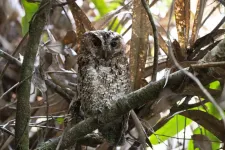INFORMATION:
Mini 3D brain models could speed up search for MS treatments
2021-05-03
(Press-News.org) Tiny 3-D models that mimic vital aspects of the human nervous system have been developed in a step that could accelerate drug research for neurological conditions such as multiple sclerosis (MS).
The millimetre-wide models - created using stem cells from human skin samples - will be used to study myelin, an insulating substance that helps nerve cells communicate with each other.
Researchers say the models are the most natural representation of human myelination developed in a lab and are a promising platform for studying neurological diseases and for testing drugs for conditions linked to myelin loss, including MS.
Nerve cells are found in the brain and the spinal cord and connect to each other with branch-like links called axons, which have an insulating coat similar to electric cabling. This insulating coat is called myelin, and it aids the electrical and chemical information flow between cells.
Damaged myelin underlies a number of neurological conditions including MS - an incurable disease affecting more than 100,000 people in the UK - and leads to a wide range of symptoms, including mobility issues, fatigue and vision problems.
Scientists at the University of Edinburgh's Anne Rowling Regenerative Neurology Clinic and the Euan MacDonald Centre for Motor Neuron Disease Research developed their human myelin model using skin samples donated by volunteers.
Skin cells were reprogrammed into induced pluripotent stem cells, which can be turned into other cell types - in this case - spinal cord cells.
These cells were then grown slowly into organoids - 3-D structures of cell bundles including neurons and distinctive brain cells known as oligodendrocytes that are key to creating myelin.
Crucially, the researchers were able to see myelin developing spontaneously around the axons between cells within the organoids.
By looking at the axons under a microscope, they could see that the myelin in this model was functioning as it would in a healthy brain or spinal cord.
The research team then created an organoid using stem cells from a patient with a rare gene mutation that affects myelination. The model showed that key aspects of this cell bundle were consistent with the disease.
These new models will allow scientists to compare the differences between the cells of healthy individuals and those with different neurological diseases and to test drugs of interest in human cells before using them in a full clinical trial with patients.
The researchers hope that their model will overcome the challenges of studying the human brain and nervous system at the cellular level, which is extremely difficult due to problems accessing brain and spinal cord tissue without risk and huge inconvenience to patients.
The approach complements animal models, which can be limited in how they reflect human disease and the way that drugs interact with human cells.
The authors say the model is a significant step forward in the study of human myelination and drug development, but caution that treatments tested on this model are still some way from being offered to patients.
The study was funded by the Euan MacDonald Centre and is published in the journal Developmental Cell with DOI: 10.1016/j.devcel.2021.04.006. The research was carried out in collaboration with the UK Dementia Research Institute and the MS Society Centre for MS Research at the University of Edinburgh.
Lead researcher, Dr Owen Gwydion James, said: "Demyelinating disorders have a profound effect on the quality of life for patients. Now we have the capability of studying human myelination experimentally, a major goal is to identify drugs that can promote myelination. We believe that this new approach could be a huge boost to the toolbox that allows us to do this effectively."
ELSE PRESS RELEASES FROM THIS DATE:
COVID-19 conspiracy beliefs increased among users of conservative and social media
2021-05-03
PHILADELPHIA - Belief in conspiracies about the COVID-19 pandemic increased through the early months of the U.S. outbreak among people who reported being heavy users of conservative and social media, a study by Annenberg Public Policy Center (APPC) researchers has found. ...
Stress and mental health problems during first COVID-19-lockdown
2021-05-03
Many people in Switzerland experienced considerable psychological distress during the first COVID-19 lockdown from mid-March to the end of April 2020. Researchers from the Department of Child and Adolescent Psychiatry and Psychotherapy at the University Hospital of Psychiatry Zurich (PUK) and the University of Zurich in collaboration with the La Source School of Nursing have now examined the most common sources of stress among children, adolescents, their parents and young adults. For their study, the researchers used representative samples in Switzerland of 1,627 young adults aged 19 to 24 as well as 1,146 children and adolescents between the ages of 12 and 17 and their parents.
Uncertainty, disruption, postponement
"Uncertainty during last year's lockdown was considerable ...
Flatfish got weird fast due to evolutionary cascade
2021-05-03
HOUSTON - (May 3, 2021) - Ever look at a flatfish like a flounder or sole, with two eyes on one side of its head, and think, "How did that happen?"
You're in luck. Rice University biologist Kory Evans has the answer.
"Flatfishes are some of the weirdest vertebrates on the planet, and they got weird very, very fast by changing multiple traits at once over a short period of time," said Evans, an assistant professor of biosciences at Rice who specializes in studying the evolution of fish over long time scales.
Of all mammals, reptiles, birds, amphibians and fish, flatfish are easily the most asymmetric. Evans, the corresponding author ...
Equipping crop plants for climate change
2021-05-03
Biologists at Ludwig-Maximilians-Universitaet (LMU in Munich) have significantly enhanced the tolerance of blue-green algae to high light levels - with the aid of artificial evolution in the laboratory.
Sunlight, air and water are all that cyanobacteria (more commonly known as blue-green algae), true algae and plants need for the production of organic (i.e. carbon-based) compounds and molecular oxygen by means of photosynthesis. Photosynthesis is the major source of building blocks for organisms on Earth. However, too much sunlight reduces the efficiency of photosynthesis because it damages the 'solar panels', i.e. the photosynthetic machineries of cyanobacteria, algae and plants. A team of researchers led by LMU biologist Dario Leister has ...
Genetics, not the intrauterine environment, controls abnormal development
2021-05-03
New Haven, Conn. --Yale researchers have shown that developmental abnormalities, including those that lead to pregnancy loss and autism, are controlled by the genetics of the fetus and placenta -- and not the mother's intrauterine environment.
The findings are reported in the April 28 online edition of the journal Placenta.
One out of every 33 children is diagnosed with a birth defect each year in the United States, according to the Centers for Disease Control and Prevention (CDC). This translates into one baby born every 4 ½ minutes -- or 120,000 per year.
"Mothers ...
Newly identified saber-toothed cat is one of largest in history
2021-05-03
COLUMBUS, Ohio - A giant saber-toothed cat lived in North America between 5 million and 9 million years ago, weighing up to 900 pounds and hunting prey that likely weighed 1,000 to 2,000 pounds, scientists reported today in a new study.
The researchers completed a painstaking comparison of seven uncategorized fossil specimens with previously identified fossils and bone samples from around the world to describe the new species. Their finding makes a case for the use of the elbow portion of the humerus - in addition to teeth - to identify fossils of large saber-toothed cats whose massive forearms enabled ...
Review outlines approaches to deliver radiation to tumors while sparing healthy tissue
2021-05-03
CHAPEL HILL, North Carolina--A comprehensive review by University of North Carolina researchers and colleagues highlights the optimal ways that focused, high-dose radiation can be delivered to various types of tumors while sparing normal tissue and mitigating long-term side effects. The review was reported as a special issue in the International Journal of Radiation Oncology, Biology, Physics on May 1, 2021.
This analysis was based on an exhaustive review of data and the literature published largely in the past decade. It updates an earlier review that primarily focused on the effects of conventional radiation therapy on normal tissue. This new review also includes important analyses ...
Short-term exposure to air pollution may impede cognition; Aspirin could help
2021-05-03
Exposure to air pollution, even over the course of just a few weeks, can impede mental performance, according to a new study led by researchers at Columbia University Mailman School of Public Health. However, these adverse effects were lessened in people taking nonsteroidal anti-inflammatory drugs (NSAIDs) like aspirin. The study is among the first to explore short-term air pollution exposures and the use of NSAIDs to mitigate their effects. The results are published in the journal Nature Aging.
Examples of events that would increase someone's exposure to air pollution over the short term could include forest fires, smog, second-hand cigarette smoke, charcoal ...
Bornean rajah scops owl rediscovered after 125 years
2021-05-03
The Bornean subspecies of Rajah scops owl (Otus brookii brookii), documented in the wild for the first time since 1892, may be its own unique species and deserving of a conservation designation. Published April 28 in The Wilson Journal of Ornithology, Smithsonian Migratory Bird Center ecologist Andy Boyce reported the rediscovery and photographed this elusive subspecies in the mountainous forests of Mount Kinabalu in Sabah, Malaysia.
"It was a pretty rapid progression of emotions when I first saw the owl--absolute shock and excitement that we'd found this mythical bird, then pure anxiety that I had to document it as fast as I could," Boyce said. "Based on size, eye color and habitat, I knew it was the Bornean Rajah scops owl. What's more, taking into ...
Social cognition plays a key role in everyday lives of people with multiple sclerosis
2021-05-03
East Hanover, NJ. May 3, 2021. An international team of multiple sclerosis (MS) researchers showed that longitudinal changes in social cognition are associated with psychological outcomes of daily living, suggesting that social cognition may exert a central role in people with MS. The article, "Social Cognition in Multiple Sclerosis: A 3-Year Follow-Up MRI and Behavioral Study" (doi: 10.3390/diagnostics11030484) was published on March 9, 2021, in Diagnostics. It is available open access at https://www.ncbi.nlm.nih.gov/pmc/articles/PMC8001246/.
The authors are Helen M. Genova, PhD, of Kessler Foundation's Center for Neuropsychology ...




